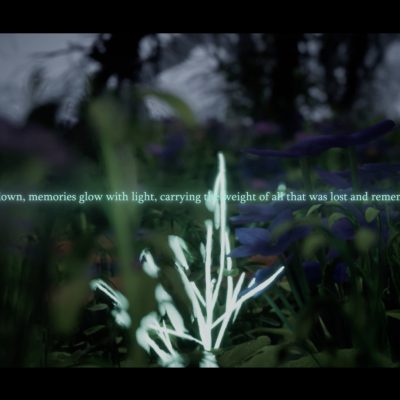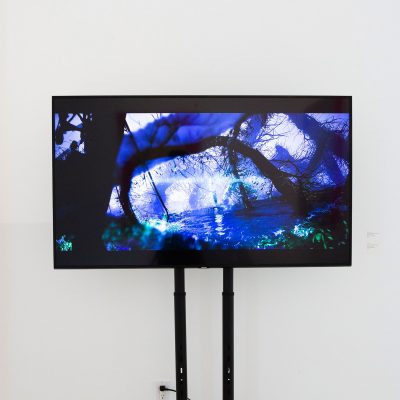
The poetics of memory, longing and diasporic experience take centre stage in Xiao Ge’s practice. Drawing on spatial symbolism and heritage traditions, the multimedia artist–primarily working in video, installation and digital forms—constructs contemplative visual environments where absence, fragmentation, and distance become tools for narration.
記憶的詩意、遷徙的惆悵、流散的體驗,在葛霄的藝術實踐中交織成深邃的景致。這位擅長影像、裝置與數位媒介的創作者,運用空間隱喻與傳承的智慧,構築出令人沉思的視覺場域。在這裡,空缺、碎片與距離都化作敘事的筆墨。

Still Image of “Memory and Displacement”, 2024. Courtesy of the artist.
In a video piece, created as part of her series Memory and Displacement (2024) for example, the artist guides the viewer through a post-digital gardenscape to metaphorically elucidate how our sense of selfhood is inextricably tied to memory and how both can be shaped through mediated spaces of viewing.
Within the first few frames, the obsidian nadirs to which we’re plunged appear to be far from welcoming; exfoliated branches whet and straggle overhead and there’s an undoubtedly uncanny atmosphere at play. But as we venture further into the fray, thickets glitching at close range, the scene is illuminated by plants, growing wildly from a lake beneath the trees. At the water’s surface, an octagonal medallion revolves, the luminescence of its labyrinthine pattern a life and light source for the flora that surrounds it.
在《Memory and Displacement》系列影像中,她引領觀者漫步於後數位花園,以隱喻闡述自我意識與記憶的共生關係,以及二者如何透過經過媒介折射的觀看空間被重新塑造。
初始畫面中,我們陷入的幽暗深淵顯得冷峻而疏離。枯枝如鏤空的冠冕在頭頂交織,瀰漫著難以名狀的微妙氛圍。隨著深入這片虛實交織的領域,近處搖曳的樹叢間漸現生機:樹木環繞的湖水中,植物恣意生長。水面中央,一枚八角徽章緩緩旋轉,其迷宮紋路綻放的微光,成為滋養四周草木的生命之源。
In this piece, and throughout her practice, Xiao Ge draws on East Asian aesthetic traditions such as ma meaning negative space as well as the integration of spiritual, natural and human dimensions to contemplate the idea of a shifting self, never fully fixed. In navigating between Chinese and English culture, Xiao has learned to live with partial views; fragments of scent, sound and sight that exist both in harmony and discord.
葛霄在這件作品及整個創作脈絡中,融匯了東亞美學中的「間」(日語 ma,即留白的智慧),以及精神、自然與人文維度的交融,思辨著永恆流動的主體性。遊走於中西文化之間的經歷,讓她學會在殘缺的視界中安住:那些既和諧又矛盾的氣息、聲響與記憶碎片,共同構築了她的藝術語言。

Still Image of “Memory and Displacement”, 2024. Courtesy of the artist.
In one of the final frames of her work, text reads “To grow up diasporic is to carry a house that no longer exists–one built not of walls but of memory, language and distance.” The floating emblem in this work is imagined by Xiao not only as an anchor and beacon of memory–tethering us to home–but also as a window or method of seeing.
在影像的尾聲,文字如漣漪般浮現:「成长于流散,便是背负一座已逝的家,以记忆为砖,以语言与距离为墙。(To grow up diasporic is to carry a house that no longer exists–one built not of walls but of memory, language and distance.)」 水面上漂浮的徽章,被藝術家賦予雙重意象:既是繫住鄉愁的記憶座標,更是一扇窺見自我的窗。
In Chinese landscape architecture, there is an idea called “borrowed scenery” in which a window frames a distant mountain, tree or rock so that it appears as if a painting or a part of the architecture itself. In traditional “scholar gardens” too, windows are intentionally designed to inspire the viewer to project their own emotional responses into its vacant frame. Xiao adopts these sentiments here, her “window” rendered as an individually mapped lens through which identity is shaped directly. As it continuously turns and refracts, it shines a light into the places we had reconciled hard to reach, lost to time or darkened by a sense of un-belonging.
中國傳統園林中的「借景」手法,將遠山、樹木納入窗框,使其成為流動的畫卷。文人園林的窗景,往往刻意留白,邀請觀者將自身情感投射其中。葛霄延續這一脈絡,將她的「窗」轉化為可個體化映射的棱鏡。身份認同在此被直接塑造。當這扇窗持續轉動、折射,它終將照亮那些我們曾經妥協的角落,那些被時光湮沒或被疏離籠罩的暗處。
By Millen Brown-Ewens
Published on 24th October 2025






